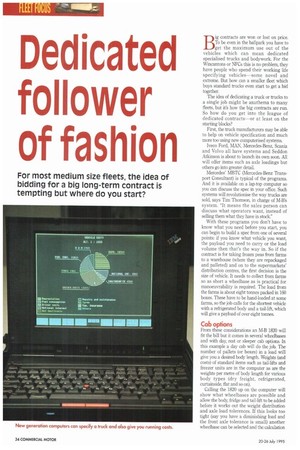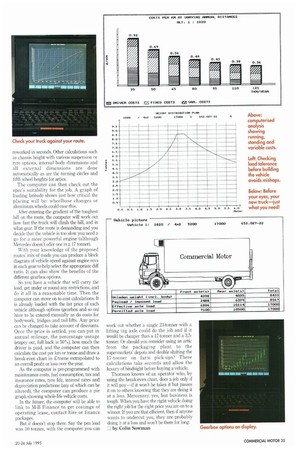Dedicated follower of fashion
Page 36

Page 37

If you've noticed an error in this article please click here to report it so we can fix it.
For most medium size fleets, the idea of bidding for a big long-term contract is tempting but where do you start?
Big contracts are won or lost on price. To be even in the ballpark you have to get the maximum use out of the vehicles which can mean dedicated specialised trucks and bodywork. For the Wincantons or NFCs this is no problem, they have people who spend their working life specifying vehicles—some novel and extreme. But how can a smaller fleet which buys standard trucks even start to get a bid together.
The idea of dedicating a truck or trucks to a single job might be anathema to many fleets, but it's how the big contracts are run. So how do you get into the league of dedicated contracts—or at least on the starting blocks?
First, the truck manufacturers may be able to help on vehicle specification and much more too using new computerised systems.
Iveco Ford, MAN, Mercedes-Benz, Scania and Volvo all have systems and Seddon Atkinson is about to launch its own soon. All will offer items such as axle loadings but others go into greater detail.
Mercedes' MBTC (Mercedes-Benz Transport Consultant) is typical of the programs. And it is available on a lap-top computer so you can discuss the spec in your office. Such systems will revolutionise the way trucks are sold, says Tim Thomson, in charge of M-B's system. It means the sales person can discuss what operators want, instead of selling them what they have in stock."
With these programs you don't have to know what you need before you start, you can begin to build a spec from one of several points: if you know what vehicle you want, the payload you need to carry or the load volume then that's the way in. So if the contract is for taking frozen peas from farms to a warehouse (where they are repackaged and palleted) and on to the supermarkets' distribution centres, the first decision is the size of vehicle. It needs to collect from farms so as short a wheelbase as is practical for manoeuvrability is required. The load from the farms is about eight tonnes packed in 160 boxes. These have to be hand-loaded at some farms, so the job calls for the shortest vehicle with a refrigerated body and a tail-lift, which will give a payload of over eight tonnes.
Cab options
From these considerations an M-B 1820 will fit the bill but it comes in several wheelbases and with day, rest or sleeper cab options. In this example a day cab will do the job. The number of pallets (or boxes) in a load will give you a desired body length. Weights (and costs) of standard items such as tail-lifts and freezer units are in the computer as are the weights per metre of body length for various body types (dry freight, refrigerated, curtainside, flat and so on).
Calling the 1820 up on the computer will show what wheelbases are possible and allow the body, fridge and tail-lift to be added before it works out the weight distribution and axle load tolerences. If this looks too tight (say you have a diminishing load and the front axle tolerance is small) another wheelbase can be selected and the calculation
reworked in seconds Other calculations such as chassis height with various suspension or tyre options, internal body dimensions and all external dimensions are done automatically as are the turning circles and fifth wheel heights for artics.
The computer can then check out the spec's suitability for the job. A graph of loading latitude shows just how critic-al the placing will be: wheelbase changes or aluminium wheels could ease this
After entering the gradient of the toughest hill on the route, the computer will work out how fast the truck will climb the hill, and in what gear. If the mute is demanding and you decide that the vehicle is too slow you need a go for a more powerful engine (although Mercedes doesn't offer one in a 17 tonner).
With your knowledge of the proposed routes' mix of roads you can produce a block diagram of vehicle speed against engine revs in each gear to help select the appropriate diff ratio. It can also show the benefits of the different gearbox options.
So you have a vehicle that will carry the load, get under or round any restrictions, and do it all in a reasonable time. Then the computer can move on to cost calculations. It is already loaded with the list price of each vehicle although options (gearbox and so on) have to be entered manually as do costs for bodywork, fridges and tail-lifts. Any price can be changed to take account of discounts. Once the price is settled, you can put in annual mileage, the percentage useage (empty out, full back is 50%), how much the driver is paid, and the computer can then calculate the cost per km or tonne and draw a break-even chart in .£/tonne extrapolated to an overall profit or loss over the year.
As the computer is pre-programmed with maintenance costs, fuel consumption, tax and insurance rates, tyre life, interest rates and depreciation predictions (any of which can be altered), the computer can produce a pie graph showing whole-life vehicle costs.
In the future, the computer will be able to link to M-B Finance to get costings of operating lease, contact hire or finance packages.
But it doesn't stop there. Say the pea load was 10 tonnes, with the computer you can work out whether a single 23-tonner with a lifting tag axle could do the job and if it would be cheaper than a 17-tonner and a 3.5tonner. Or should you consider using an artic from the packaging plant to the supermarkets' depots and double shifting the 17-tormer on farm pick-ups? These calculations take seconds and allow the luxury of hindsight before buying a vehicle.
Thomson knows of an operator who, by using the break-even chart, does a job only if it will pay—if it won't he takes it but passes it on to others knowing that they are doing it at a loss. Mercenary, yes, but business is tough. When you have the right vehicle doing the right job for the right price you are on to a winner. If you are that efficient, then if anyone wants to undercut you, they are probably doing it at a loss and won't be there for long. 0 by Colin Sowritan




























































































